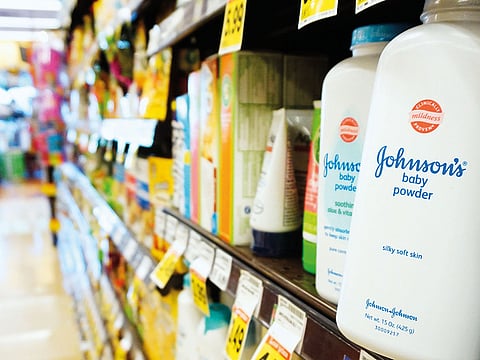What is talc, where is it used and why is asbestos a concern?
Talc is used in lipstick, mascara, blush, eye shadow, foundation and children’s makeup

Johnson & Johnson on Friday forcefully denied a media report that it knew for decades about the existence of trace amounts of asbestos in its baby powder.
The report sent the company’s shares into a tailspin, suffering their worst one-day sell-off in 16 years. Reuters cited documents released as part of a lawsuit by plaintiffs claiming that the product can be linked to ovarian cancer. The New Brunswick, New Jersey company has battled in court against such claims and on Friday called the report “one-sided, false and inflammatory”.
But Johnson & Johnson’s stock fell $14.84 (Dh54.5), or 10 per cent, to close Friday at $133, its most severe single-day decline since 2002. The report noted documents show consulting labs as early as 1957 and 1958 found asbestos in J&J talc. Further reports by the company and outside labs showed similar findings through the early 2000s.
In its statement Friday, Johnson & Johnson said “thousands of independent tests by regulators and the world’s leading labs prove our baby powder has never contained asbestos.” Asbestos is a carcinogen considered unsafe at any level of exposure, but how is it linked with talcum powder?
What is talc, and why is asbestos relevant?
Talc is a mineral in clay mined from underground deposits. It’s the softest mineral known to man, and that makes it useful in a wide range of consumer and industrial products. Asbestos is also found underground, and veins of it can often be found in talc deposits, leading to a risk of cross-contamination, geologists say.
Are any other consumer products made with talc?
Talc is used in many cosmetics: lipstick, mascara, face powder, blush, eye shadow, foundation and even children’s makeup. In the list of ingredients, it can be listed as talc, talcum or talcum powder, cosmetic talc or magnesium silicate. Talc is added to cosmetics to create a silky feel and absorb moisture. Some brands make talc-free cosmetics.
Talc is also used in food processing, and to make some supplements, pharmaceutical pills, chewing gum and polished rice. Consumer groups have also found it in crayons and children’s toys, like crime-scene fingerprint kits.
Talc was routinely applied to surgical gloves and condoms until the 1990s, when the Food and Drug Administration told manufacturers to stop using it because of health concerns.
And it’s typically the primary ingredient in baby powder. Johnson’s Baby Powder is made of talc, unless the bottle says “pure cornstarch” on the front. If you’re using another brand, check the ingredients.
Should I keep talc away from my baby?
Yes. Paediatricians have been warning parents for decades not to use powder on babies because of the risk a child will inhale or aspirate talc, which can cause choking and coughing and lead to respiratory illness or chronic disease and lung damage. This has nothing to do with asbestos.
Cases of babies dying from choking on powder were reported as early as the 1960s, and since 1981, the American Academy of Paediatrics has taken a strong position against the use of talc on babies and children, saying it is hazardous and has no medicinal value.
Is there a safe alternative?
Paediatricians suggest changing infants’ diapers frequently to prevent rashes, and recommend using an oil-based ointment when necessary, rather than using talc.
For teenagers or adults, cornstarch is a good alternative to using talc on the skin or genital area to stay dry and prevent chafing and irritation.
If it’s a product for babies, why are women suing?
Broadly speaking, the women claim the powder caused their ovarian cancer because they used it for feminine hygiene for decades, and may have also inhaled airborne powder. Some have argued that the talc mineral itself caused their cancer, while more recently, the claim emerged that it was asbestos contaminating the talc.
What does Johnson & Johnson say about the claims?
Johnson & Johnson has the largest share of the talcum powder market, and has been selling Baby Powder and other similar products for more than 100 years. The company says that its talc does not contain asbestos, that claims that talc causes cancer are based on bad science, and that it is appealing any jury verdicts against it.
Has the FDA tested talc products for asbestos recently?
The FDA last tested talc products in 2010 and found no asbestos, but it was provided raw talc from only four suppliers and tested only 24 commercial products. Experts who have analysed talc on behalf of plaintiffs suing Johnson & Johnson say they have detected asbestos in talc products. The FDA does not test cosmetics for safety. With the exception of colour additives, neither makeup nor any of its ingredients require the agency’s approval. The agency says it takes the possible presence of asbestos in cosmetics very seriously but manufacturers and marketers are responsible for their safety.
It points to voluntary standards set by the manufacturers’ trade association, the Personal Care Products Council, which declared in 1976 that all talc products should be free of asbestos. The council has no way of enforcing the standard.
Sign up for the Daily Briefing
Get the latest news and updates straight to your inbox





